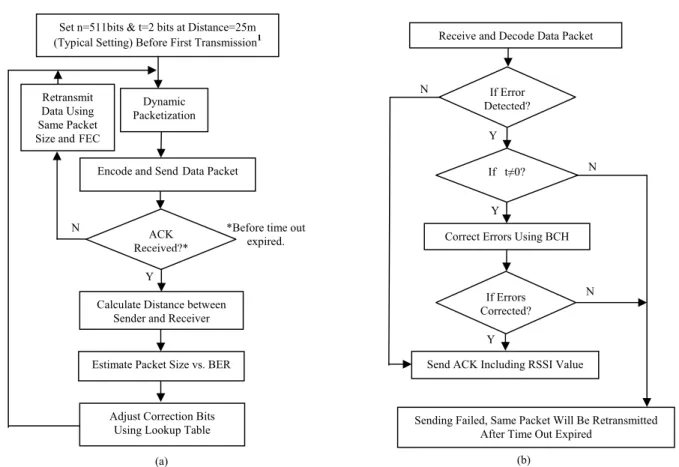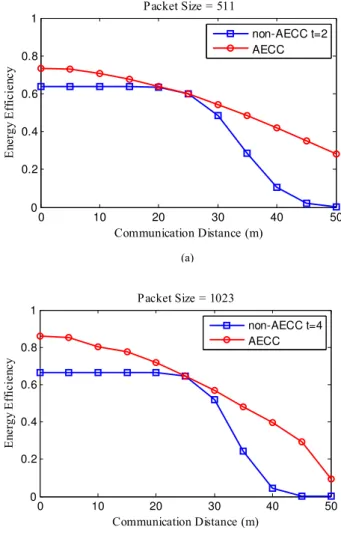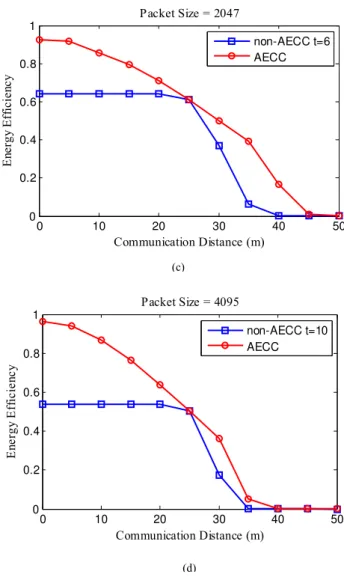Energy Efficiency Analysis of Adaptive Error Correction in
Wireless Sensor Networks
Ghaida A. AL-Suhail1, Khalid W. Louis 2, and Turki Y. Abdallah3
Computer Engineering Department, College of Engineering, University of Basrah Basrah, IRAQ
Abstract
In this paper, we develop an analytical energy efficiency model using adaptive error correction code (AECC) in wireless sensor networks in fading environments. To adapt energy efficiency of sensor node to channel variations, the packet length is tuned at the data link layer. In this model, we consider the error control of Bose-Chaudhuri-Hochquengh (BCH) coding for NC-FSK receiver node using AECC scheme and compare it to one of non-AECC. The analysis is based on Mica2 sensor node where a look-up table of distance vs. adaptive correction code is installed in the node sender. Depending on channel state variation via the ACK feedback, the sender can adjust the adequate BCH code required for the next transmission. The numerical results show that the AECC scheme can significantly improve the energy efficiency for the long link distance and under various packet lengths over Rayleigh fading channel.
Keywords: BCH Coding, Adaptive Coding, Energy Efficiency, Fading Channels, Wireless Sensor networks.
1. Introduction
The emergence of wireless sensor networks (WSNs) has currently become increased with wide-ranging applications from health, home, and environmental to military, space and commercial. They are a special case of ad-hoc wireless networks where the constraints on resources are especially tight [1], WSNs are composed of nodes typically powered by batteries, for which replacement or recharging is very difficult. With finite energy, a finite amount of information can only be transmitted. Therefore, minimizing the energy consumption for data transmission becomes one of important design considerations for WSN in most application scenarios. Moreover, the channel fading has also a great effect on the reliability of data transmission and energy consumption in WSN. As a result, the design of energy efficient strategies to prolong lifetime or minimize the energy consumption is still of utmost and critical importance issue in WSN design [2][3]. Wireless sensor networks require simple and facile error control schemes because of the low complexity request of sensor
nodes. Automatic repeat request (ARQ) and forward error correction (FEC) are the key error control strategies in wireless sensor networks. There have been some studies that consider the energy efficiency of error control techniques in sensor networks.
In [4], an optimization metric of energy efficiency is proposed. This model exactly describes the energy efficiency in sensor networks and many subsequent researches [5][6][7] are based on this model. For example, the authors in [4] examine the energy efficiency of ARQ and they indicate that retransmission strategy of ARQ cannot improve the energy efficiency in sensor networks. Nevertheless, this conclusion is not accurate or comprehensive. In [8], energy efficiency of FEC is studied. They reveal that the energy efficiency of BCH code outperforms any other channel codes due to its low encoding and decoding energy consumption. Accordingly, BCH code is used in our work. Although the basic ARQ protocols provide error control capabilities, they have several drawbacks. In order to overcome the drawbacks, a hybrid scheme consisting of the combination of ARQ and FEC were used and is referred to as hybrid ARQ. The FEC subsystem increases the system throughput by correcting most of the frequently occurring error bits in the transmitted packets. When a detectable but not correctable error is being realized, an ARQ retransmission is requested thus increasing the system reliability. As a result, the combination of FEC and ARQ scheme provides higher reliability than a system operating only with FEC, and higher throughputs than a system operating only with ARQ. In this paper, the mathematical analysis for energy efficiency of HARQ is presented. The result of our analysis reveals that there is an optimum error correction capability with the largest energy efficiency for a target communication distance and packet size.
2. Proposed System Model
In this paper, we consider the sender of wireless sensor with adaptive error correction capability as shown in Fig. 1. At the sender, the optimum error correction capability (t) chooses from Look-up Table depending on the packet size and the distance between neighbouring sensors to achieve the best energy efficiency. Where the packet size varies based on BER in an inverse relationship. ARQ controller and BCH controller of HARQ are both considered to provide error protection on the transmitted data. BCH controller is responsible for adding channel coding to packet at the physical layer; and if the BCH decoder at the receiver fails in correcting the bit errors in the packet then ARQ controller retransmits the entire packet after timeout expired, if t=0 then only ARQ subsystem of HARQ system is to be activated; otherwise HARQ is activated. Received signal strength indicator (RSSI) is a measurement of the power present in a received radio signal. At the sender, when ACK packet is received, the value of RSSI feedback is used to estimate the distance between neighbouring sensors. At the first transmission, initially minimum packet size (511 bits) is sent with error correction bits (t) equals 2 bits. For more illustration, Fig. 2 explains the events sequence between the sender and receiver. Figure 3 summaries the details of the mechanism based on the ACK feedback to adapt the required error correction to the next packet transmission. This feedback refers to RSSI indicator.
2.1 Channel Estimation
We first estimate the raw channel bit error rate (BER) for typical wireless sensor networks. The probability of bit
error is evaluated under a non-coherent FSK modulated Rayleigh fading channel model in wireless sensor networks, is defined as follows [4]:
SNR
P
bNCFS+
=
−
2
1
, (1)
SNR(dB)
=
77-10β
log(
d
)
(2)where
β
is the path loss exponent. (Assume a typicalβ
= 3.5).According to the receiver implementation, signal-to-noise ratio (SNR) depends on the neighbor distance d between sensor nodes. The path loss is the average propagation loss as a function of the distance d on the order of β.
2.2 Optimization Metric
The energy efficiency η is a suitable metric that captures the energy and reliability constraints, which is defined as [4]:
(
PER
)
E
E
R
total eff
e
=
−
=
η
.
1
η
(3)where ηe is the energy throughput, R= (1 - PER) is the packet acceptance rate, which accounts for data reliability, and Eeff / Etotal denotes the energy throughput. Therefore, the energy efficiency η represents the useful fraction of the total energy expenditure in a communication link between neighbouring sensors.
1
- Assume ED and FEC are added to each packet prior to transmission
3. Adaptive Error Control Analysis
The energy efficiency analysis is based on Mica2 sensor node [9] with ATmega128L processor [10] and CC1000 radio module [11]. Energy consumption of HARQ can be expressed as:
EHARQ=Etran+Ere+Edec (4) where encoding energy is considered to be negligibly small value [4] and Edec is the decoding energy. For a t error correction binary BCH code the decoding energy
Edec can be expressed as [12]:
E
decI
procV
proc(
nt
t
)
m
3
t
cycle8
2
2
.
2⎟
⎠
⎞
⎜
⎝
⎛
+
=
(5)where Iproc is the current for processor, Vproc is the supply voltage, tcycle is one cycle duration of processor, n is the total data packet size and m = log2 n +1 [13]. And the expression for the energy efficiency of HARQ defined as: *Before time out
expired.
Y
N Y
N
Y
N Set n=511bits & t=2 bits at Distance=25m
(Typical Setting) Before First Transmission1
Encode and SendData Packet
Calculate Distance between Sender and Receiver
ACK Received?* Retransmit
Data Using Same Packet Size andFEC
Dynamic Packetization
Estimate Packet Size vs. BER
Adjust Correction Bits
Using Lookup Table N
Y
Fig. 3 Proposed Adaptive Error Coding System in Wireless Sensor Network (a) Sender node (b) Receiver node If Error
Detected?
If t≠0?
Sending Failed, Same Packet Will Be Retransmitted After Time Out Expired
Receive and Decode Data Packet
Correct Errors Using BCH
If Errors Corrected?
Send ACK Including RSSI Value
0 10 20 30 40 50 0 0.2 0.4 0.6 0.8 1
Communication Distance (m)
En e rgy E ff ici en c y
P acket Size = 1023
non-AECC t=4 AECC
0 10 20 30 40 50
0 0.2 0.4 0.6 0.8 1
Communication Distance (m)
E n e rg y E ff ici en cy
P acket Size = 511
non-AECC t=2 AECC
R
E
N
T
V
I
I
n
T
V
I
I
dec tr radio re tr tr radio re tr×
+
+
−
−
+
=
)
(
)
(
)
(
α
τ
η
(6)where Itr , Ire , Vradio are the transmit current, receive current and the supply voltage for CC1000, Ttr = 1/Rradio is the time consumed to transmit 1 bit by CC1000, sum of header and frame check sequence (FCS) size, τ=m * t, N =
n +lACK +RSSI and R is packet reliability:
t
(
b)
Ni i i bp
p
i
N
R
=⎟⎟
−
−⎠
⎞
⎜⎜
⎝
⎛
=
∑
1
0 (7) Eq. (6) is a bounded function with 0 < η< 1 and its values vary along the error correcting capability t which is always an integer, length of the packet and distance between communication pairs. For ARQ, energy efficiency is independent of retransmission attempts and is unchangeable with the number of retransmission [14].
4. Simulation Results
4.1 System Settings
Parameters settings are based on the Mica 2 series WSNs platform of Crossbow Company, which are given by Table1.
Table 1: Parameter Settings
4.2 Performance Evaluation
In this section, the AECC scheme was compared with one of non-AECC, in terms of energy efficiency based on different communication distances and data packet size using HARQ error control over Rayleigh fading channel. The interval of the distances in simulation is 5 meter because of the location error in WSNs. The energy
efficiency of two types of error control scheme is all sharply reducing with increasing of communication distance. Energy efficiency of AECC scheme decreases to some degree, but the performance of this scheme is maintained relatively well with increasing of communication distance for various packet size.
In Fig. 4(a), (b), (c) and (d) the energy efficiency of AEEC and non-AECC schemes were compared over 50m communication distance and packet size of 511, 1023, 2047 and 4095 bits, respectively. For non-AECC scheme each packet size has error correction capability t of constant value independent on variation of communication distance. It is clearly noticed that the energy efficiency of AECC scheme is better than that of non-AECC, so AECC is the optimal error control scheme.
Parameters Symbol
Definition Quantity Sum of header and FCS size 11 bytes lACK+RSSI Packet length of ACK and RSSI 9 bytes
Vradio Supply voltage for radio 3V
Vproc Supply voltage for processor 5V
Iproc Current for processor 8mA
tcycle One cycle duration of processor 250ns
Itr Transmit current 8.5mA
Ire Receive current 7mA
Rradio Data rate 38.4kbaud
(a)
0 10 20 30 40 50 0
0.2 0.4 0.6 0.8 1
Communication Distance (m)
E
n
er
g
y
E
ff
ici
en
cy
Packet Size = 4095
non-AECC t=10 AECC
0 10 20 30 40 50
0 0.2 0.4 0.6 0.8 1
Communication Distance (m)
En
ergy
Eff
ici
en
cy
Packet Size = 2047
non-AECC t=6 AECC
5. Conclusion
In this paper, energy efficiency of error control schemes in wireless sensor networks is discussed. The maximal energy efficiency of HARQ technique can be achieved by adaptation of error correction capability for a target communication distance and packet size. Moreover, AECC is compared with non-AECC scheme in terms of energy efficiency based on different communication distances and packet lengths.
References
[1] M. Vieira, C.N. Coelho, D.C. da Silva, "Survey on Wireless Sensor Network Devices," IEEE Conf. Emerging Technol. Factory Autom., pp. 537-544, Sep. 2003.
[2] P. Lettieri, C. Fragouli, and M.B. Srivastava, "Low Power Error Control for Wireless Links," ACM/IEEE Int. Conf. Mobile Comput. Netw., pp. 139-150, 1997.
[3] E. Shih, S. H. Cho, F. S. Lee, B. H. Calhoum, and A. Chandrakasan, "Design Considerations for Energy-Efficient Radios in Wireless Microsensor Networks," J. VLSI Signal Process, vol. 37, no. 1, pp. 7794, May 2004.
[4] Y. Sankarasubramaniam, I. F. Akyildiz, S. W. McLaughlin, "Energy efficiency based packet size optimization in wireless sensor networks," IEEE Internal Workshop on Sensor Network Protocols and Applications, pp. 1 -8, 2003.
[5] Z.H. Kashani, M. Shiva, "BCH Coding and Multi-hop Communication in Wireless Sensor Networks," International Conference on Embedded And Ubiquitous Computing (IFIP'06) , Seoul, Korea, April 11-13 2006.
[6] H. Karvonen, Z. Shelby, and C. Pomalaza-Raez, "Coding for energy efficient wireless embedded networks," International Workshop on Wireless Ad-hoc Networks 2004 (IWWAN'04), Oulu, Finland, May 31- June 3 2004.
[7] Z. Shelby, C. Pomalaza-Raez, J. Haapola, "Energy optimization in multihop wireless embedded and sensor networks," 15th IEEE International Symposium on Personal, Indoor and Mobile Radio Communications (PIMRC'04), Barcelona, Spain, Sept. 5-8 2004.
[8] G. Balakrishnan, M. Yang, Y. Jiang, Y. Kim, "Performance Analysis of Error Control Codes for Wireless Sensor Networks," Fourth International Conference on Information Technology (ITNG'07), Las Vegas, Nevada, USA, April 2-4, 2007.
[9]Crossbow Corp, “Mica2 datasheet”, [2010]
http://www.xbow.com
[10] Atmel Corp, “ATmega128 datasheet”, [2010]
http://www.atmel.com.
[11] Chipcon Corp, “CC1000 datasheet”, [2010]
http://www.chipcon.com
[12] Z. Tian, D.F. Yuan and Q.Q. Liang. "Energy Efficiency Analysis of Error Control Schemes in Wireless Sensor Networks," In Proc. of Wireless Communications and Mobile Computing Conference (IWCMC2008). IEEE Press, Crete Island, Greece, pp: 401-405, August 2008.
[13] M.C. Vuran, I.F. Akyildiz, "Cross-Layer Analysis of Error Control in Wireless Sensor Networks," 3rd Annual IEEE Communications Society on Sensor and Ad Hoc Communications and Networks (SECON '06), Hyatt Regency, Reston, VA, USA, Sep. 25-28, 2006.
[14] A. E. Babiker, M.Nordin, B.Zakaria "Energy Efficiency Analysis of Error correction Techniques in Underwater Wireless Sensor Networks," Journal of Engineering Science and Technology, February 2011, Vol. 6(1).
Fig. 4 Energy efficiency of AECC and non-AECC for different packet sizes and communication distance
Authors
Ghaida A. AL-Suhail received the Ph.D. Degree in Electrical Engineering from the University of Basrah, in 2007; Currently is an Assistant Professor at the University of Basrah, Computer Engineering Department, Basrah, IRAQ; Her current research interests include Wireless Networks and communications, Mobile Multimedia, Image Processing, Internet Protocols, Cross-layer Design, Quality of Service, Modelling and Simulation, and Mobile Computing. She has been a Fulbright Scholar 2011 at the Michigan State University (MSU) in USA and Endeavour Fellowship 2009 Scholar at the Australian National University (ANU), RSISE, in Australia; she is co-author of Book Chapter 13
with M. Fleury and S. M. Al-Majeed, (2011), “Mobile Video
Streaming Over Heterogeneous Networks”, Book Title: Innovations in Mobile Multimedia Communications and Applications: New Technologies, Edited by Ismail Khalil and Edgar R. Weipl, IGI Global, pp. 175-200; and author and co-author of International Journals and Conferences papers like JMM, IJMCMC, IJCNC, IJWMN, WSEAS’06, ICARCV’06, MoMM08/ 2009, ICSPCS7/8/9/2010 (Australia and USA), WiMo2011 (Turkey) and EPC-IQ01 and CCIT2012 (IRAQ).
Khalid W. Louisreceived B.E. degree in Computer Engineering from University of Basrah in 2010; he is currently MSc. Student at the Computer Engineering Department, University of Basrah, IRAQ; his research interests include wireless sensor networks, routing algorithms, network simulator Castalia, modelling and simulation and fuzzy logic systems.



